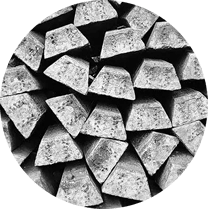
Limits for drinking water: Sb 5 µg/l; Cr 50 µg/l; Cd 5 µg/l; Cu 1000 µg/l (1 mg/l); Ni 20 µg/l; Pb 10 µg/l; Hg 1 µg/l; Se 10 µg/l; Ag 50 µg/l
- No color, taste or odor
- chronic poisoning, organs and body functions damage
Water cleaning
- Solution principle – coagulation, adsorption, reverse osmosis, special ion exchanger
Heavy metals are, for example, chrome, copper, silver, lead, nickel, mercury or cadmium. In nature, they are rare and are not well soluble in water. They can get into water as a result of acid rain, landfill leakage, or industrial wastewater discharge.
If they are present in their dissolved form, they are mostly toxic to humans, aquatic organisms and the environment as a whole. Acute poisoning (i.e. ingestion of a single dose with immediate effect) should not occur. However, chronic poisoning can be a threat. Regular intake of small doses manifests after a certain time by different health problems (depending on the particular metal). Heavy metals tend to accumulate in organisms (the body can not excrete or decompose them).
Fortunately, relatively simple methods can be used to eliminate the problem. Coagulation is used in the water industry; for smaller sources, the adsorption on activated carbon, special ion exchangers or reverse osmosis are selected. Most important, however, is preventing the discharge of these metals to the environment and water sources. It is therefore necessary to comply with the procedures for wastewater disposal, not to create illegal landfills and to place dangerous waste (e.g. mercury containing lamps) in the recycling centers. Material of water distribution piping should also be chosen with care.


